You’ve seen fiddle-leaf fig trees all over Instagram, Pinterest and your favorite magazine cover. So you want to get one! Wondering how to care for a fiddle-leaf fig tree? Your plant BFF is here to help!
After a few years of owning a fiddle-leaf fig tree, I finally feel (mostly) prepared to write this article! Fiddle-leafs are like hormonal teenagers – they’re happy one second and sad/mad/annoyed and dropping leaves like crazy the next.
We now have three fiddle-leaf trees of varying sizes: a small one we recently got, a middle size one we’ve had for a couple years and a giant one we’ve had for quite a while.
Our giant fiddle-leaf fig tree was the one we learned the most on. (My best tip: don’t do that.) Fiddle-leaf fig trees are expensive, so it’s best to learn a smaller one – our little one only cost $14.99 from IKEA! – so if your new plant happens to croak, you’re not out too much money!
First let’s chat about the background of the fiddle-leaf.
Table of Contents
Fiddle Leaf Fig Tree Facts
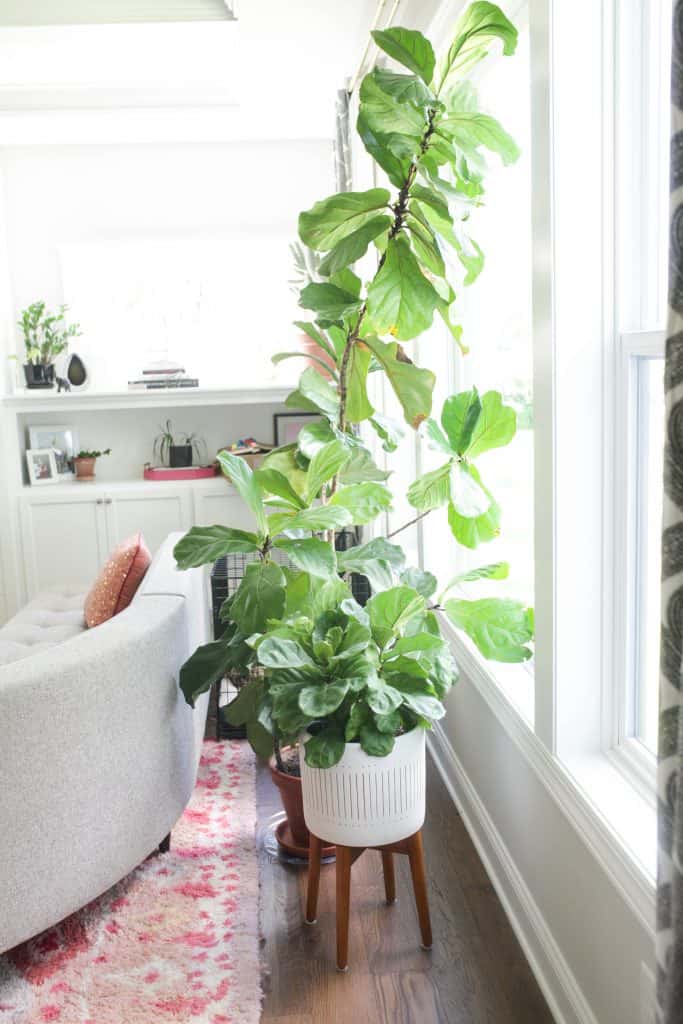
The fiddle-leaf fig’s proper name is Ficus lyrata. It’s in the fig/mulberry family, Moraceae. These tropical plants are native to Cameroon in Africa, which is hot, humid and often rainy. This is what makes them challenging to grow them as an indoor plant because how many of us live in hot humid places?
This plant can grow up to 50 feet outdoors or 10 feet tall indoors. They are fairly fast growers with large leaves which makes them really fun to have, but make sure they have enough room!
With proper care and the right conditions, the Fiddle Leaf Fig Trees can be a statement plant in any home. Today I’m going to share all it is that I’ve learned about these beautiful plants!
Fiddle Leaf Fig Tree Care
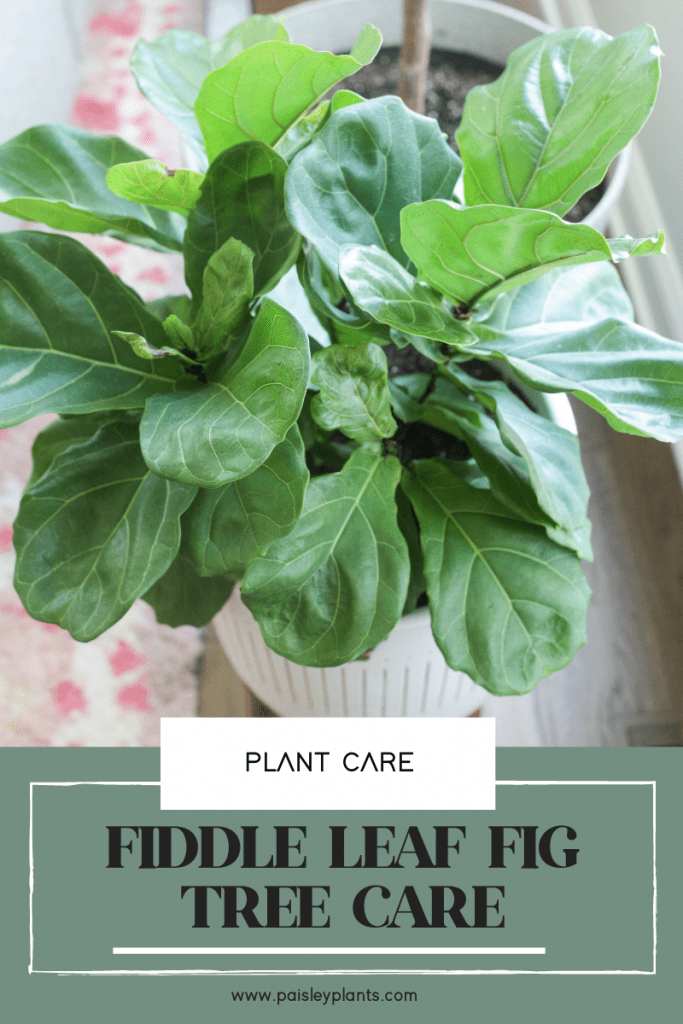
Paisley Plants is a participant in the Amazon Services LLC Associates Program This post may include affiliate links which means I may earn a small commission if you shop using the links below at no additional cost to you. Thanks so much for supporting me and this blog!
Once you know what type of sun and water levels your fiddle-leaf fig likes, they’re actually not too hard to care for!
Like most plants (and people) it’s not a one-size-fits-all situation. Every fiddle-leaf fig tree is a little different, so use these care instructions as a starting point to care for yours!
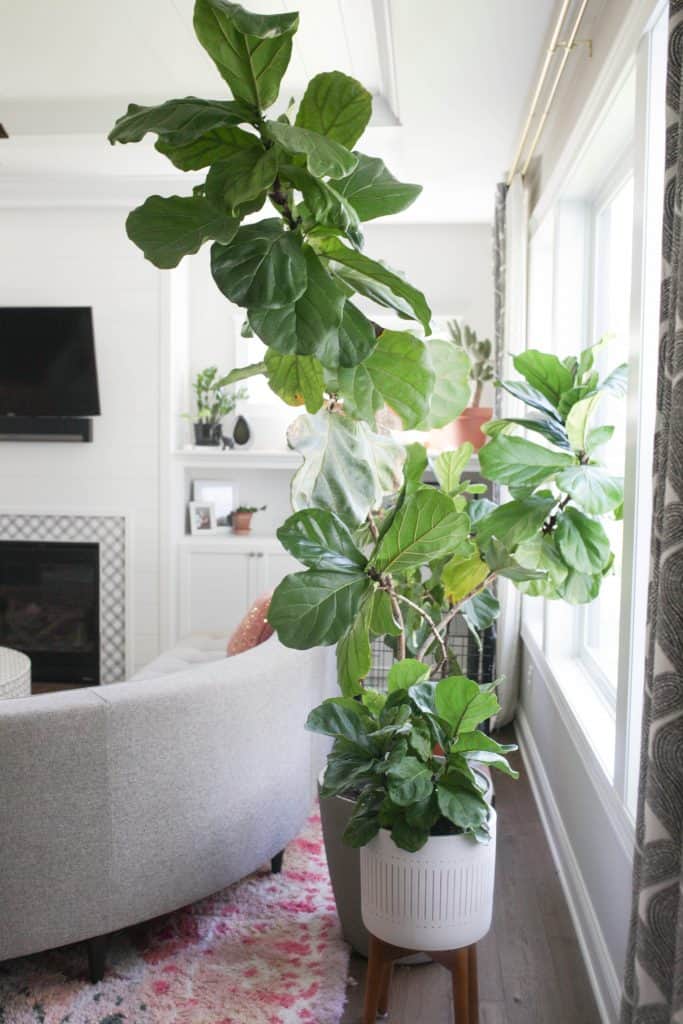
Water
When it comes to water, fiddle-leafs need a moderate amount of water, typically preferring to be watered about every 8-10 days.
Your best bet is to do the finger test – stick your finger into few inches of soil. If it’s dry, water it, and if it’s still wet, don’t! If your pot is extra large, you could also get a moisture meter to take the guess work out of it! It’s harder to tell how wet or dry your plant’s soil is at the bottom of the pot if the pot is huge!
You can tell if your fiddle-leaf fig tree needs water by looking at the leaves. If they start to look floppy or droopy it’s time to water them! Under-watering them can result in a loss of leaves.
However, don’t overwater them so they get soggy soil! This can result in root rot which can be detrimental to your plant. This is where it can be hard. Your plant needs enough water to thrive but too much water is bad.
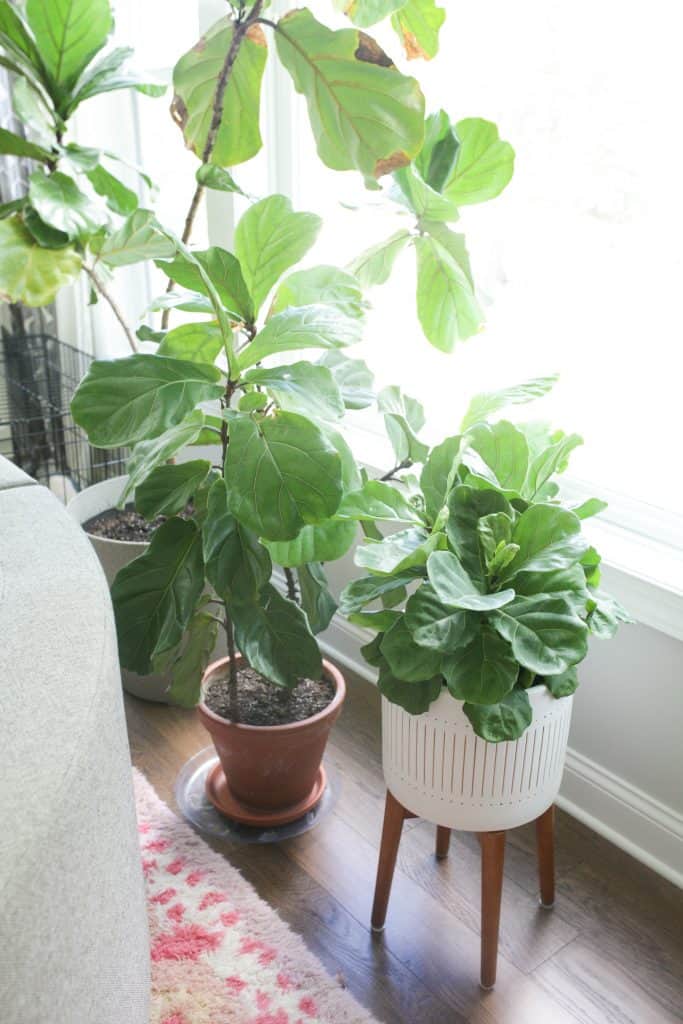
I always err on the side of not enough in the beginning so you don’t get root rot. Keep an eye on the leaves of your plant. If they start drooping they likely need more water.
If your plant goes through a season when you forget to water your plant and it’s really droopy you can water it from the bottom (assuming your plant has drainage holes). Simply fill a large sink or bathtub with water and let it sit in the water for 15-20 minutes.
Your plant will absorb the perfect amount of water and will perk up in the next 24 hours. It’s like magic! 🙂 I did this after forgetting to water my plant before going on vacation. While it did lose a few leaves from being severely under watered, it perked up so much literally 24 hours after bottom watering it!
Light
Fiddle Leaf Fig trees need bright, indirect light to survive. Indirect means something such as a sheer curtain. Many experts say that too much direct sunlight is bad for your plant. I actually nix the curtain and all three of my plants get full, bright sun in a large west-facing window.
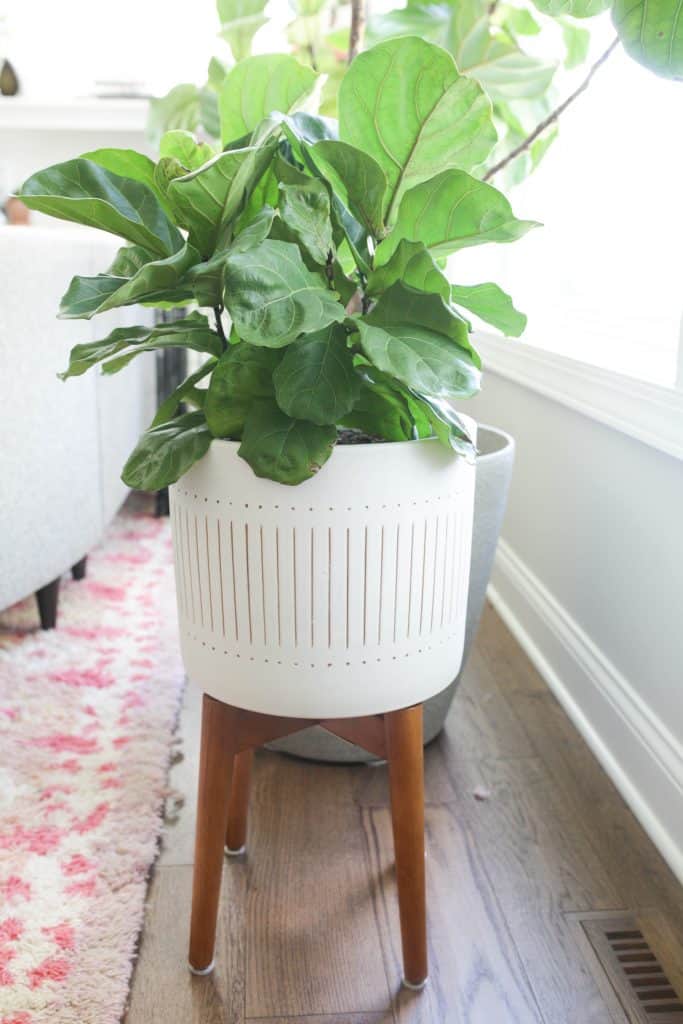
Our first tree was in an east-facing window and it was not happy. One key sign that your fiddle-leaf fig tree isn’t getting enough light is that it starts to drop leaves. While a leaf drop or two can be natural due to a plant getting older, too many leaves dropping can be a sign of wrong growing conditions.
Fiddle Leaf trees can be grown both outdoor if you live in a place with warm weather or as an indoor plant. I’ve started putting my plants outside during the summer months and they thrive!
When I have my plants outside during the summer months (aka their growing season), I keep them out of too much direct sunlight however. I’ve burned leaves of my plants by giving them too much sun outside in the summer!
Soil
Choose a well draining soil when potting your Fiddle Leaf Fig. Ideally you want the soil to have something like peat moss or coconut coir to encourage the water to move through and drain properly.
There’s plenty of great options of soil out there to chose from. There’s some Fiddle Leaf Fig House Plant Soil that are specific to Fiddle Leaf plants so you’ll be certain your giving your plant the right blend of soil, peat, sand, etc.
However, you can also get a regular indoor potting soil mix and likely have a great soil for your plant. Personally I use a regular indoor potting soil and it works just fine!
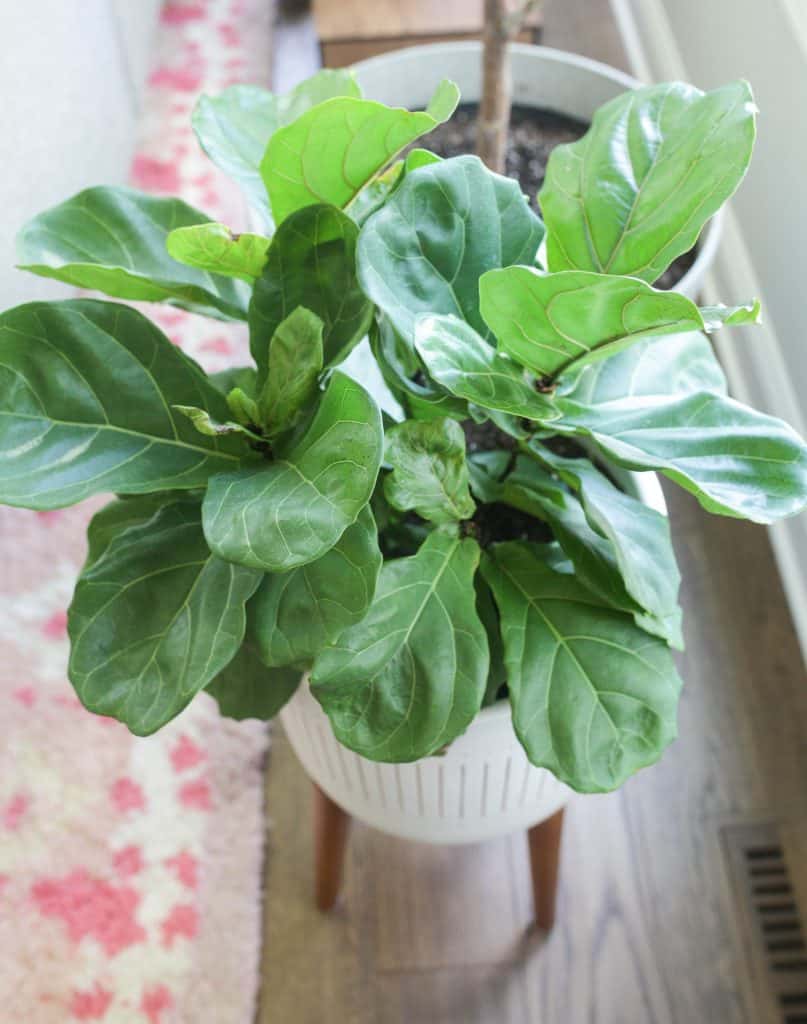
Temperature and Humidity
Fiddle Leaf Fig plants will do well in most comfortable temperatures but don’t do well in a place where there is cold drafts or heating vents. These plants do really bad when there’s sudden changes in temperature or humidity levels. It’s a good idea to try to keep their growing conditions as consistent as possible!
You should also mist the leaves every couple of weeks especially in the winter. This mimics the humidity it likes!
If you live in a really dry area with low humidity, a humidifier might be a good option for your plant (and let’s be real, you too!). Some plants that are on the smaller size can benefit from a tray of stones and pebbles and water placed underneath the plant to help increase the humidity.
For larger fiddles this likely won’t do enough and a humidifier is a better option.
When it comes to temperature, keep your plant in a comfortable spot between 55 and 85 degrees Fahrenheit. If you do put it outdoors be sure that you bring it inside of the temperature goes below or above that range. While outside time can be great for your plants, too cool or too warm of temperatures can be detrimental.
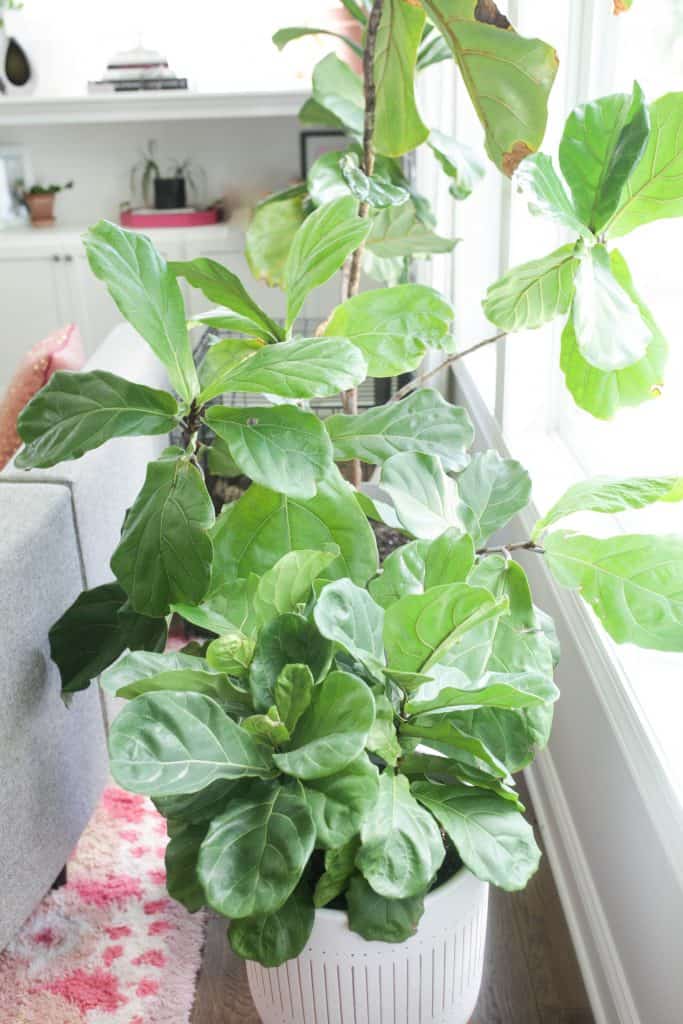
Toxicity
This plant is mildly toxic to dogs and cats (according to ASPCA). It can cause skin irritation and digestive issues in both pets and curious kiddos!
If you want a pet (and kid) friendly plant, check out these non-toxic plants!
Fertilizer
Fertilizing your fiddle-leaf fig plant is a great idea. You should fertilize your plant at least spring through fall. I really like using this fiddle-leaf fig food that can be used every time you water your plant.
It’s not necessary to fertilize your plant in the winter when it’s dormant but adding it in the spring time will help promote new leaves to form.
Pests and Diseases
Like most plants, these plants can be susceptible to pests like spider mites, fungus gnats, and mealybugs. Regular cleaning of your plant’s leaves can help keep your plant clear of any pests or insects in addition to making sure you have healthy leaves and a happy plant.
Some fungal diseases to watch out for are root rot (as mentioned above) which is caused by overwatering. If you notice your leaves are dropping and it’s getting enough light, it may be time to check the roots to see if they’re soft or mushy which can mean it has root rot.
You can also check out this post which has tips on what to do if the leaves on your fiddle are turning brown!
Fiddle Leaf Fig Frequently Asked Questions
The best way to encourage a fiddle leaf fig to grow well and get new growth is to ensure it is the best growing conditions. This means a keeping it in a good amount of bright indirect light, having a consistent watering schedule, putting it in a right pot size with fresh soil and a drainage hole, not moving it to a new spot every week and wiping the leaves with a damp cloth often.
They’re not easy to keep alive, that’s for sure. Fiddle-leaf figs are notoriously finicky about light and being moved, but if you follow the tips on this post, you can make a happy home for your fiddle-leaf.
It’s important to keep your fiddle-leaf fig’s leaves clean to keep the plant healthy! I like to use a simple water bottle filled with water and spray the leaves directly and wipe them clean with a rag or paper towel.
Clean the top and bottom of the leaf to ensure all the dust is wiped off. Pay special attention to the veins where dust can easily accumulate.
This depends a big on where they are. When grown indoors, the fiddle leaf fig plant can grow up to 10 feet tall (if you have the space for that).
There are things that come into play on the size of your fiddle leaf fig – how big the pot is, how much light it’s getting, and your pruning and repotting routines.
Where to buy a fiddle-leaf fig tree?
- Start with a local nursery especially if you’re looking for a big one
- The Sill
- Amazon
- Home Depot
- IKEA
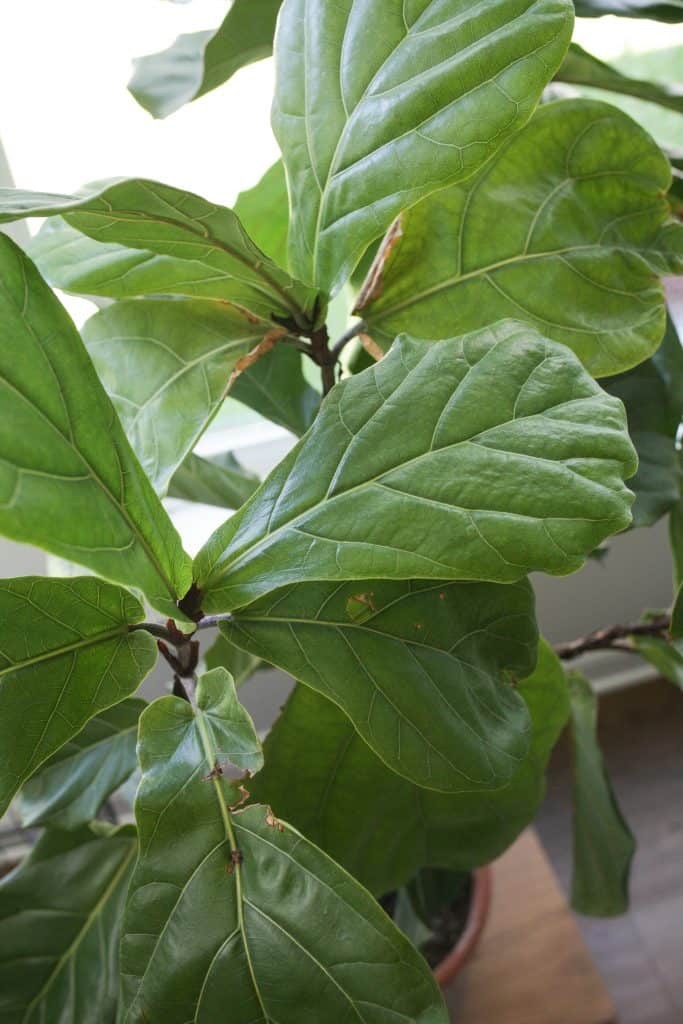
I hope this Fiddle Leaf Fig plant care post helps take all the guesswork out of growing your own ficus lyrata! Please let me know what questions you still have or check out these posts for more fiddle leaf fun!
If you love ficus plant, be sure to check out our Rubber Plant care guide or our Ruby Rubber Plant guide if you love pink plants!
Check out some of these fun tall plants!


The leaves on my fiddle leaf fig are turning brown and are brown. I kept it on my screened patio all summer it was beautiful. What should I do?
I would check on the light source now vs on your patio. Is it getting enough light? Too much light? What changed? Start there and see if you can figure out what your plant needs.